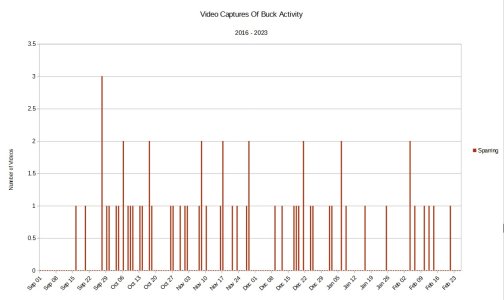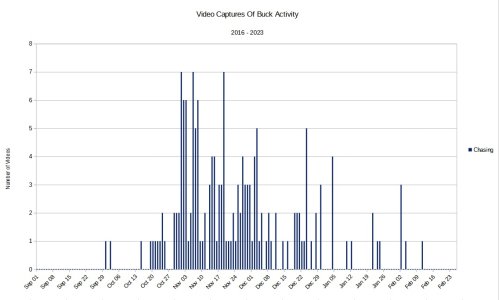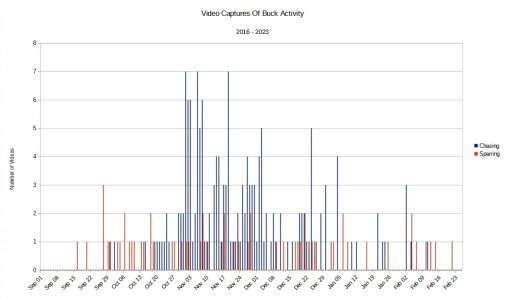bigbendmarine
5 year old buck +
Start by sharing that data analysis has been a big part of my 30+ year career... and being honest, as with MANY data studies involving small data sample sets evident patterns have to be taken with a grain of salt and more questions are typically generated than can be answered...
With the above out of the way, for the past seven years, I've used trail cameras to capture videos on my place (in North Florida just outside Tallahassee) and for those videos showing either chasing or sparring activity I've labeled them as such.
With much debate amongst some local hunting friends about when rutting starts, peaks, cycles, ends, etc... I thought it would be interesting to count how many videos I got of sparring on each given day and to also separately count how many videos of chasing I got on each given day. Should add that with the charts I'm sharing I did NOT worry about any possible variation by year, but instead simply amassed data points for the specific day regardless of year. For example, if I had videos of bucks sparring on 10/01/16 and 10/01/22 I counted that as 2 events for my label of Oct 1. While recording each event in my spreadsheet I did include the year so that later down the road, I might be able to re-analyze for any shifting among years. Also will stress that I only counted uniquely different chases / sparring activities. If I got 4 videos in one minute of the same buck sparring event, I only counted that as one data point entry.



My guarded takeaways?
1) A bit surprisingly, sparring seemed pretty evenly spread throughout the rutting season. Looks to be a bit more activity in late September and early October, with bucks likely trying to clarify pecking order before actually mating... but still quite an even amount across the season.
2) Not surprisingly, sparring activity occurred both before chasing started and after chasing ended -- likely due to testosterone levels waxing before mating and waning after does all tended.
3) Not really a takeaway, but an observation -- in my neck of the woods bucks appear to do way, way, WAY more lighter sparring than heavy fighting. Or at least that's true in front of cameras as almost ALL of my captures were of relatively light sparring, and this isn't due to low deer density or low counts of bucks. Counts are quite high in my area. I know some heavy fighting occurs as both juvenile and adult bucks lose tines during season, but again as captures go the vast majority of action is light sparring / more neck wrestling than efforts to kill.
4) Whereas sparring is somewhat evenly spread across the season chasing definitely appeared to peak early to mid-November but with somewhat regular even if declining activity through mid-January. Mid-January to mid-February showed a much lighter/irregular spike of activity of what I'm guessing is bucks seeking out any yearling does going into heat after the more mature does.
5) Definitely gives me comfort on not feeling an extreme sense of urgency each season to kill bucks the first week, even if that week is one of the most active -- seven years hunting the area has done the same as I've killed about as many bucks feeding later in the season as I have bucks chasing during peak rut. Our gun season runs from early Nov through late January and couldn't match the activity levels noted on my chart any better.
6) I went in with somewhat a suspicion that there might be a more clearly defined 1st rut, 2nd rut, and 3rd rut periods with clear breaks between them.. and while the data ***somewhat*** shows the possibility of such periods becoming clearer with additional data, it's not exactly like activity completely abates... though there interestingly does appear to be a slight lull around the second week of December... very interested to see how future data points strengthen or weaken the definition of distinct periods.
Now for a couple of the questions I'm left with...
1) Are nearby friends who speak of dramatically different observations (or lack thereof -- swearing they aren't seeing ANY rutting signs into mid-Dec) smoking crack?
2) How much are warm / cold snaps influencing daytime versus night rutting activities (while I recorded year in each data point, I didn't record day vs night nor temps -- likely will go back and do that).
3) With additional data will 1st rut, 2nd rut, and 3rd rut cycles become more apparent OR will it continue to look more like breeding activity just slowly and somewhat consistently wanes over time with different does going into heat at varying times, and the chasing activity slowing as fewer and fewer does are left untended?
Know I'm quite a distance from many forum members, but still thought some would find the exercise interesting... and that others who've captured videos for years might be able to try the same to see what patterns you see if interested.
With the above out of the way, for the past seven years, I've used trail cameras to capture videos on my place (in North Florida just outside Tallahassee) and for those videos showing either chasing or sparring activity I've labeled them as such.
With much debate amongst some local hunting friends about when rutting starts, peaks, cycles, ends, etc... I thought it would be interesting to count how many videos I got of sparring on each given day and to also separately count how many videos of chasing I got on each given day. Should add that with the charts I'm sharing I did NOT worry about any possible variation by year, but instead simply amassed data points for the specific day regardless of year. For example, if I had videos of bucks sparring on 10/01/16 and 10/01/22 I counted that as 2 events for my label of Oct 1. While recording each event in my spreadsheet I did include the year so that later down the road, I might be able to re-analyze for any shifting among years. Also will stress that I only counted uniquely different chases / sparring activities. If I got 4 videos in one minute of the same buck sparring event, I only counted that as one data point entry.



My guarded takeaways?
1) A bit surprisingly, sparring seemed pretty evenly spread throughout the rutting season. Looks to be a bit more activity in late September and early October, with bucks likely trying to clarify pecking order before actually mating... but still quite an even amount across the season.
2) Not surprisingly, sparring activity occurred both before chasing started and after chasing ended -- likely due to testosterone levels waxing before mating and waning after does all tended.
3) Not really a takeaway, but an observation -- in my neck of the woods bucks appear to do way, way, WAY more lighter sparring than heavy fighting. Or at least that's true in front of cameras as almost ALL of my captures were of relatively light sparring, and this isn't due to low deer density or low counts of bucks. Counts are quite high in my area. I know some heavy fighting occurs as both juvenile and adult bucks lose tines during season, but again as captures go the vast majority of action is light sparring / more neck wrestling than efforts to kill.
4) Whereas sparring is somewhat evenly spread across the season chasing definitely appeared to peak early to mid-November but with somewhat regular even if declining activity through mid-January. Mid-January to mid-February showed a much lighter/irregular spike of activity of what I'm guessing is bucks seeking out any yearling does going into heat after the more mature does.
5) Definitely gives me comfort on not feeling an extreme sense of urgency each season to kill bucks the first week, even if that week is one of the most active -- seven years hunting the area has done the same as I've killed about as many bucks feeding later in the season as I have bucks chasing during peak rut. Our gun season runs from early Nov through late January and couldn't match the activity levels noted on my chart any better.
6) I went in with somewhat a suspicion that there might be a more clearly defined 1st rut, 2nd rut, and 3rd rut periods with clear breaks between them.. and while the data ***somewhat*** shows the possibility of such periods becoming clearer with additional data, it's not exactly like activity completely abates... though there interestingly does appear to be a slight lull around the second week of December... very interested to see how future data points strengthen or weaken the definition of distinct periods.
Now for a couple of the questions I'm left with...
1) Are nearby friends who speak of dramatically different observations (or lack thereof -- swearing they aren't seeing ANY rutting signs into mid-Dec) smoking crack?
2) How much are warm / cold snaps influencing daytime versus night rutting activities (while I recorded year in each data point, I didn't record day vs night nor temps -- likely will go back and do that).
3) With additional data will 1st rut, 2nd rut, and 3rd rut cycles become more apparent OR will it continue to look more like breeding activity just slowly and somewhat consistently wanes over time with different does going into heat at varying times, and the chasing activity slowing as fewer and fewer does are left untended?
Know I'm quite a distance from many forum members, but still thought some would find the exercise interesting... and that others who've captured videos for years might be able to try the same to see what patterns you see if interested.
Last edited:

